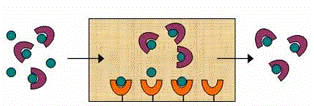Chemistry, Department of: Faculty Series

David Hage Publications
Document Type
Article
Date of this Version
2015
Citation
Published as Chapter 1 in Senta Reichelt (ed.), Affinity Chromatography: Methods and Protocols, Methods in Molecular Biology, vol. 1286, pp 1–19. DOI: 10.1007/978-1-4939-2447-9_1
Abstract
Affinity chromatography is one of the most selective and versatile forms of liquid chromatography for the separation or analysis of chemicals in complex mixtures. This method makes use of a biologically related agent as the stationary phase, which provides an affinity column with the ability to bind selectively and reversibly to a given target in a sample. This review examines the early work in this method and various developments that have lead to the current status of this technique. The general principles of affinity chromatography are briefly described as part of this discussion. Past and recent efforts in the generation of new binding agents, supports, and immobilization methods for this method are considered. Various applications of affinity chromatography are also summarized, as well as the influence this field has played in the creation of other affinity-based separation or analysis methods.


Comments
Copyright © 2015 Springer Science+Business Media New York. Used by permission.